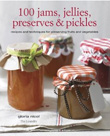BOTTLING TOMATOES & THE ACIDITY CUSP
Monday August 16th 2010, 1:05 pm
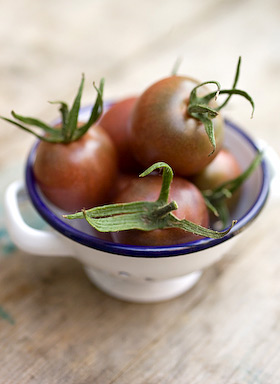
Month eight Tigress’s can jam canning challenge and for August the ingredient chosen by the inspired and inspiring Julia is tomatoes. My relationship with this ubiquitous fruit has been a checkered one. I hated tomatoes as a kid but learnt to tolerate them later on. I do like them as a sauce for pizza, applied with a lightness of touch though. I can now eat cherry tomatoes raw and, like biting into any fruit, appreciate their sweetness so I suppose you could say I’ve made progress.
But it is as objects of beauty that tomatoes especially come into their own. The resurgence of interest in growing heritage varieties has brought all these wonderfully coloured tomatoes to the fore; striped, heart and pear shaped, shaded like a shop display of lipsticks, from gold to chocolate. They are all so fantastically photogenic and worth growing for looks alone.
As an ingredient for canning, they are on the acidity cusp. Tomatoes require special attention for bottling safely using the water processing method or else should be pressure canned. They are only just on the acid side of neutral and acidity can vary for different varieties, so it is necessary to add a little more acidity in the form of lemon juice or citric acid to make sure they stay safely putt. It is important that time spent preserving has a very definite pay off later so it makes sense for me to bottle really useful tomato passata-type sauces for cooking up further down the line into pizza toppings, pasta sauces or as additions to winter casseroles.
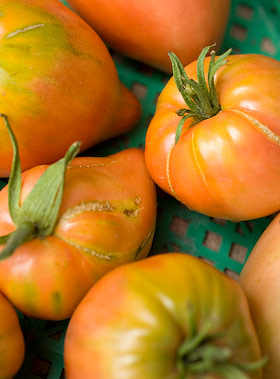
Each year I begin the growing season with high hopes for an extensive range of weird and wonderful tomato varieties. I don’t have a greenhouse so can only grow toms out in the open. We’ve had two consecutive years of blight bringing these plans to a soggy and disappointingly diseased halt, but this year the weather has been kinder. Tinned tomatoes are as cheap as chips, so I don’t think it is really cost effective to bottle tomatoes unless you have your own homegrown supply or you are able to mop up someone elses glut. The plants I have growing in the garden are still some way from the ‘glut’ stage. Thankfully my neighbour Jane has a greenhouse as well as green fingers. She sells her excess garden produce from her garden wall. Last week I picked up four generous punnets of yellow and red tomatoes from the wall and dropped my payment into the honesty box provided.
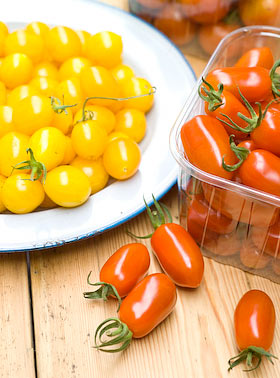
So first a basic tomato sauce. These cherry tomato varieties are as sweet as anything though perhaps not the most ideal kinds for bottling. For sauces, larger fleshy varieties like Roma and San Marzano are good. Skinning so many tiny fruits was definitely out of the question for starters. Tomatoes can be very watery, which means that they will require considerable cooking to reduce, thicken and intensify the flavour, unless some of the liquid is removed first.
In order to give a fresher flavoured result with less cooking time I began by slitting each fruit and removing the seeds by running my thumb quickly through their middles, collecting the seeds in a sieve placed over a bowl. Any collected juice would come in handy later. After a brief cooking time of 10 minutes the de-seeded tomatoes were then processed using a passata mill, running it through several times to separate the skins from the pulp. The passata mill is a bit of kit I acquired some years ago when dreaming of a bounteous tomato crop that never materialised. The mill has sat unused in its box ever since so this was its first opportunity to prove its worth. I must say that I wasn’t too impressed. Passata-ing the tomatoes was a messy and annoying business (compounded by trying to take photographs at the same time). Tomato juice splattered all over the place and possibly it was my fault, but juice was squirting out the handle side as well! Next time I will most likely use my regular food mill over a bowl, which though still requiring patience would be less messy and more controllable. Depending on the scale of the project, to remove skins and any stray seeds you could simply push the tomatoes through a sieve if you prefer. Still too watery for my liking, I strained the flesh again briefly in a sieve collecting more juice to add to what had been collected earlier. 2.5Kg (5 1/2lbs) of tomatoes resulted in 775g (1 3/4lbs) puree and 750ml (1.3 pts) of juice.
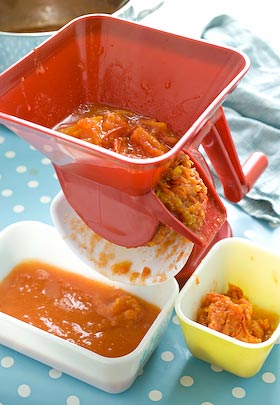
HOW TO BOTTLE TOMATO PUREE
Prepare the water bath, jars and seals ready for bottling (canning). For more info about how to hot water process, refer to the guide here.
Put the pureed tomatoes in a pan and simmer for a short time to reach a consistency that suits you so excess juice has evaporated. If the puree is already thick enough simply bring to boiling point. I added 1 tsp sea salt (a non essential, so add salt to own taste or leave out all together) plus an aditional acidic booster. As a general guide you need to add one of the following to every 500ml (1 pt) tomato puree: 1Tbsp lemon juice or 1/4 tsp citric acid. I used balsamic vinegar instead, adding 2 Tbsp balsamic vinegar per 500ml (1pt) puree.
Place a basil leaf inside each jar against the glass and fill jars with tomato, leaving headspace required for your type of jar. Remove bubbles from sides of jars using a small spatula, wipe rims clean and seal. Process 500ml (1 pt) jars for 35 mins and 1ltr (quart) jars for 45 mins. Remove jars from water bath and leave till cold before testing the seals. Any jars with loose seals will require reprocessing or you can keep them in the fridge for using up within a few days. Remember to label all your jars before storing them.
My tomatoes made 2 x 350g (12oz) jars of sauce plus a bit more that I had with pasta for my dinner that evening.
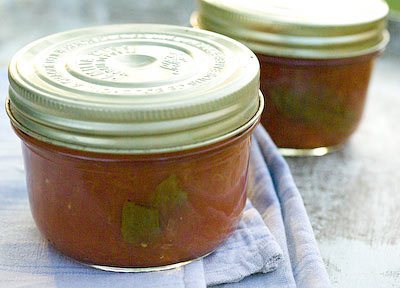
WHAT TO DO WITH THE JUICE
It seemed a shame to waste the lovely sweet juice collected whilst extracting the tomato puree, so I decided to turn it into tomato jelly. You could flavour tomato jelly with fresh ginger and ground coriander or finely chopped chilli. After much deliberation I eventually chose vanilla and white pepper for a jelly with a sweet / savoury crossover. This jelly is delicious on sourdough toast with cream cheese and I used it to fill tiny savoury pastry cases, topped with sour cream or crumbled goats cheese for a really exquisite little mouthful.
As tomato juice is lacking in pectin, a boost in the form of the addition of lemon or apple juice is helpful. Having bottled some whitecurrant juice several weeks earlier to use at times like this, I added some of that for its setting quality. Preserving sugar containing added pectin could also be employed here. Adjust proportions to suit what you have available.
TOMATO, VANILLA AND WHITE PEPPER JELLY
750ml (1.3 pts) tomato juice (a byproduct of making the puree above)
550g (1 1/4lb) sugar
Juice of 1 lemon or 150ml (2/3 cup) whitecurrant juice
1 vanilla pod, split and seeds scraped from inside
1/2 tsp ground white pepper
Prepare the water bath, jars and seals ready for canning. For more info about how to hot water process, refer to the guide here.
Pour the juice through a jelly bag, collecting the juice in a measuring jug. To every 600ml (1 pt) juice add 450g (1 lb sugar). Place all the ingredients in a preserving pan. Stir constantly over low heat until the sugar has dissolved then turn the heat up to bring to a rolling boil. Boil to setting point, (it took me about 10 minutes) when a blob of syrup on a cold plate will formed a skin when you push your finger over the top of it. If using a jam thermometer it will register 220F 105C. Remove the vanilla pod and fill hot jars, leaving the required headroom for their type. De-bubble the sides using a small spatula or chopstick, wipe jar rims clean, before sealing and placing in the hot water bath. Process for 10 minutes, remove from the bath, then leave till cold before testing the seals. Label and store.
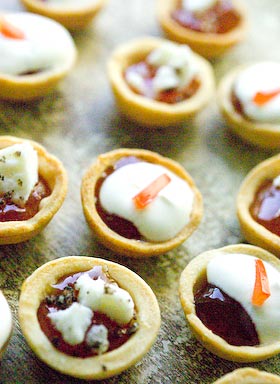
The ratio of sugar to juice is the classic one used when making jellies. This jelly is very nice indeed but I will be tempted to cut down on the amount of sugar when I make this next. It is often safe to keep jams and jellies without hot water processing (canning) them. If you do can them you are making doubly certain that they will be preserved safely for a year or even longer.
WHERE THE WILD GARLIC LIVES
Tuesday May 11th 2010, 8:32 pm
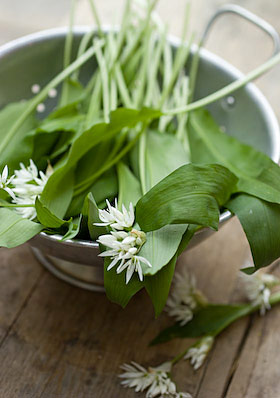
Right now, wild garlic seems to be the best thing since sliced bread. It is extraordinary that it has become such a fashionable ingredient and that people consider it somehow wacky and daring to make use if it. This poses the question, why has such a wonderful herb been overlooked for so long. Belonging to the allium family, once established in a habitat that meets its requirements, it grows prolifically forming a lush carpet of smooth pointed leaves, later topped with delicate white flowers for about 6-8 weeks in the spring. Right now, round here, it is looking just perfect and there’s loads of the stuff. It is growing in abundance all around the little chapel just a hop skip and jump from my house so I am doing my best to make the most of it.

In fact wild garlic is a really useful plant and all of its parts are edible. Someone told me today of a local ‘professional’ forager who when the flowers go over and set their seed goes round with a little portable vacuum cleaner and hoovers them up. He sells them to top restaurants for grinding as a seasoning. The flowers can be added to salads, the bulbs can be pickled and the leaves can be used to bring their delicious flavour to stir fries and of course pesto. Anyone who hasn’t tried wild garlic is missing a trick. Here is a recipe for wild garlic pesto, which might get you started on your own daring food journey. Watch out Ray Mears!
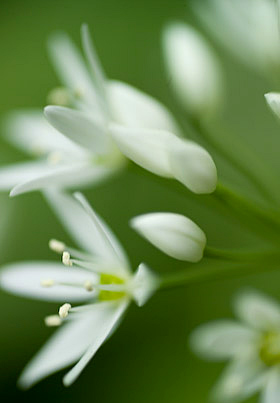
WILD GARLIC PESTO
Makes about 350g
100g wild garlic leaves
60g parmesan cheese or a similar hard cheese (I like this vegetarian one )
60g pinenuts
120ml cold pressed rapeseed oil or virgin olive oil (I’ve been using this one )
salt and pepper
Wash and dry the garlic leaves using a salad spinner or patt them dry with kitchen towel. Grate the cheese finely in a food processor then tip out into a bowl. Lightly roast the pine nuts to heighten their flavour taking great care not to overdo it or they’ll burn. Wizz the nuts in the food processor to grind them then add the cheese and half the leaves roughly torn. Blend till the leaves are finely chopped then add the rest of the leaves and blitz again. With the processor running, drizzle the oil into the pesto until it is all added and combined. Season with salt and pepper and pour into a sterilised jar for keeping in the fridge. By pouring some extra oil over the surface it should keep for a few weeks. A couple of spoonfuls stirred into linguine is just perfect and topped with a handful of chargrilled asparagus and a few Parmesan shavings makes it heaven on a plate.
You can freeze pesto, so that is the best way to extend the season for this delicious sauce. I have seen it written to leave out the cheese before freezing, but as Parmesan freezes well, I don’t think that is necessary. I have taken to freezing single portions of pesto in individual plastic containers and right now my freezer is looking well stocked.

AN OBSESSION WITH ANGELICA
Thursday April 22nd 2010, 6:12 pm
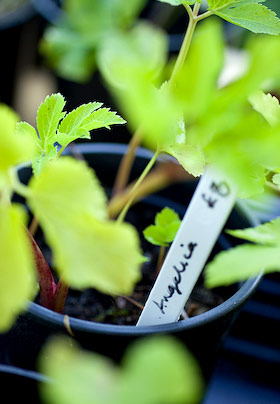
I first came across angelica, the herb, when I looked round my neighbours garden a few years ago. Jane and Les Hales’s garden is very special, so special in fact that it is open to the public a couple of days a year as part of the National Garden Scheme. Jane has planted angelica in several parts of the garden and uses this tall stately plant to form screens against the house. I was instantly impressed by the plants towering stature and amazing flowerheads that look so graphic and beautiful against blue sky.
Jane usually has a few seedlings for sale at her open days. Apparently once you manage to get angelica to grow, this biennial seeds itself freely, so restocking the plant is not an issue. I have tried growing it since then. The first two years, our wet summers encouraged the slugs to decimate my young plants, so even my best efforts came to nothing. This year is looking slightly brighter, and I already have a plant doing well on my allotment and a few more small seedlings that I am cherishing a little longer before planting them out to fend for themselves.
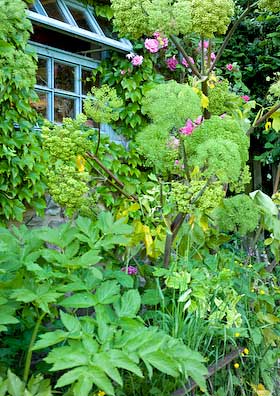
I had a vague recollection of candied angelica from my childhood, a strikingly vibrant green confectionery used to decorate trifles, a small strip pushed into the cream top layer either side of a bright red glace cherry, and can just about recall it having a rather exquisite and unusual flavour, but that was as far as my knowledge went. I certainly had no inkling that it came from a herbal or vegetable source. This of course set me off on a quest to find out more about the culinary merit of this impressive herb and I vowed to have a go at candying my own angelica to try and rediscover the distinctive flavour remembered as a kid.
All parts of the plant are aromatic and edible. The stems are the bits you candy to make confectionery, the leaves are used for flavouring many liqueurs such as chartreuse as well as in the preparation of bitters, and with juniper berries to flavour gin, the root is blended with wormwood and other herbs to make absinthe and the seeds impart a muscat-like flavour to wine and are used in the preparation of vermouth. All impressive stuff.
Stems for candying or crystallizing need to be young. It is no good waiting too long to harvest them as by June – July time they will be far too stringy and tough to work with. You will know by now that being prepared well enough ahead is not my strongest point, but this year, for once, no doubt prompted by Tigress’s can jam canning challenge I am taking part in, which has chosen herbs for our April ingredient, I have gotten round to acquiring a handful of stems and a nice bunch of leaves from Jane which she very kindly cut for me. The plan, to use angelica as my canjam ingredient (post to follow this one), but also to candy some stems at the same time.
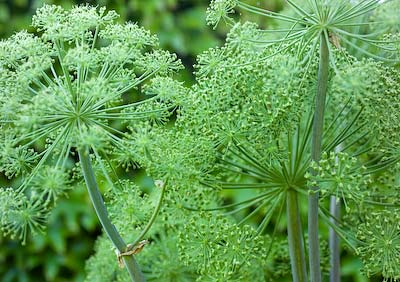
What is interesting is the point at which the angelica turns from a herby savoury scent and flavour to a sweet unctious syrupy one. The stems need first to be boiled and scraped, which is a bit fiddly, before layering them with sugar to begin the transformation. As I had very few stems to play with, I used some of the thicker leaf stalks as well. Apart from the peeling process, it was merely a matter of 5 or 10 minutes of activity followed by a day or so of leaving well alone, so it is hardly taxing. As soon as a syrup started to form, the angelica took on the magical taste I remembered and I felt as though I had captured the essence of this wonderous herb. It is worth having a go, even if you only candy angelica once in your life. The basic recipe I followed comes from Bee Nilson’s Herb Cookery, published in 1974. She is one of my favourite cookery writers for allsorts of reasons. Scale the recipe down if you don’t have enough stems.
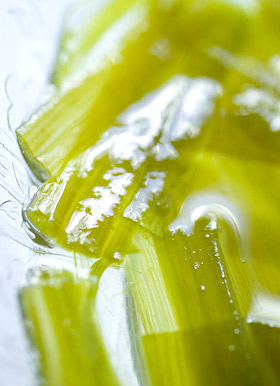
HOW TO CRYSTALLIZE ANGELICA
1/2kg (1lb) angelica stems
Wash the stems and cut into 8-15cm (3-6in) lengths. Boil them in enough water to cover until the stems are tender. For young stems this should only take about 10 minutes. Drain well, rinse with cold water and drain again. Scrape the outer skin from each piece. I found it easiest to slit down the side of each hollow tub and lay them flat on the surface. The skin comes off really easily but you need a lightness of touch so what remains isn’t damaged. Place them in a shallow dish.
1/2kg (1lb) caster sugar
Sprinkle the sugar evenly over the stems. Cover the dish and leave it for 2 days by which time the sugar will have dissolved and become syrupy.
250ml (1/2pt) water
Put the angelica, sugar syrup and water in a pan and heat whilst stirring until the syrup boils. Simmer gently until nearly all the syrup is absorbed and the angelica is clear. Add more water if the syrup has all gone but the stems aren’t looking transparent. Drain the angelica and leave till cool enough to handle, then roll them in more caster sugar to coat them generously. Spread the pieces on a wire cooling rack and finish drying them in a warm place or a very cool oven. When cold wrap the angelica in waxed paper to store.
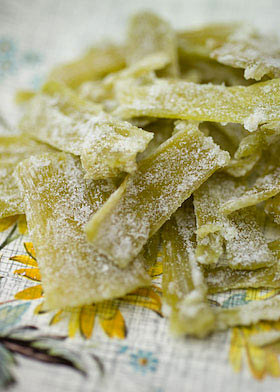
This year, Ramblers, Jane and Les Hale’s garden at Aylburton Common in the Forest of Dean, is open as part of the National Garden Scheme on two Sundays; 2nd May and 13th June 2-6 pm, and also by special appointment during May and June only. You can find more information on the National Garden Scheme website here.

WHAT DOES A SHAPE TASTE LIKE ?
Tuesday March 09th 2010, 11:43 am
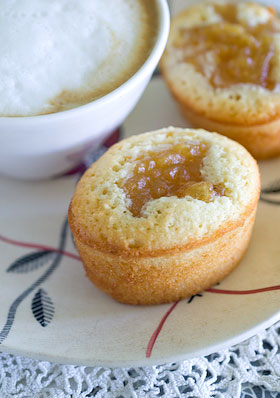
Yesterday was my day off, which just means that I have a list of jobs need doing that call for being away from the shop. With a list as long as my arm it is business almost as usual, but somehow calling it ‘my day off’ creates a whole different vibe, so long as I tackle the list, I can do what I like and pretend I’m on holiday. Even better, the sun was shining, as if spring was really here.
With no bread in for making toast I decided to rustle up some muffins or perhaps blueberry griddle scones to have with my a.m cappuccino. I opened the cupboard where the tins live and didn’t relish pulling everything out to locate the muffin tin at the back and then the friand tin fell out all of its own accord. So friands it was to be.
I have written about friands before here, and I know from the daily stats how many readers find my blog by googling friand related keywords. And no, I don’t know where you can buy a friand tin in the UK! Someone was selling them for a while, but sadly no longer and I regularly trawl the web trying to find them to sell at The Laundry as I’m sure that I could sell perhaps one a month (shopkeepers irony).
Friands are supposed to be oval shaped. Why the shape of a cake should be so important, I don’t know and I am sure that they will taste just as good baked in regular round shaped muffin moulds. Feel free to make them any shape you like. So for my day off I looked at the ingredients to hand; some whole blanched almonds left over from Christmas baking (which I ground to a rough meal in my old Magimix for this recipe), 1 bramley apple and a little bag of fresh bantam eggs, my neighbour leaves me each week, and decided to rustle up some tart bramley friands. The ground almonds make a lovely moist precious cake and this recipe is tangy, fruity but not overly sweet. Don’t forget, a friand is not just for breakfast, it isn’t really for breakfast at all, but hey, it’s my day off.
TART BRAMLEY FRIANDS
Makes about 10
1 medium sized Bramley apple or other tart variety
1 1/2 Tbsp soft brown sugar
1 1/2 Tbsp maple syrup
2 tsp vanilla extract
5 egg whites
125g ( 4oz) butter, melted
100g (1 cup) ground almonds
100g (3/4 cup) icing sugar or caster will do
60g 1/2 cup plain flour
Preheat the oven to Mk5, 190C, 375F and prepare a muffin tin by buttering the moulds.
Peel and core the apple and chop into small evenly sized pieces, then place in a small pan, sprinkling 2-3 teaspoons of water over it. Bring to a simmer and cook until it is soft and mushy, which only takes 3-5 minutes. Add the brown sugar, maple syrup and 1 tsp vanilla extact, stir and cook for another minute or 2. Add more sugar if you want it sweeter but a tart hit is what you are aiming for. Leave to cool.
In a large bowl, whisk the egg whites till just frothy. Add all the remaining ingredients and combine quickly to make a batter. Pour the mixture into the moulds, half filling them. Drop a heaped teaspoonful of the stewed apple into the centre of each friand. Bake for 20-25 minutes till risen and set and just starting to turn golden. Remove from the oven and leave to cool for 5 minutes before turning them out onto a rack to cool.
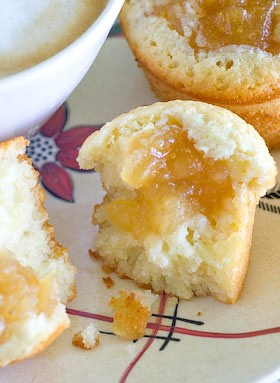
JUSTA WALKIN THE DOG
Saturday October 03rd 2009, 12:06 am

I’ve been up north for a while, celebrating my Mum’s birthday. We organised a surprise party for her and it seems it really was a total surprise. I especially enjoy walking my brother’s dogs when I’m up there, early mornings, along the banks of the River Ribble. His two Sharpei dogs bound along but do tend to scare the other dog walkers they come face to face with. They are really gentle creatures but look quite fearsome. I was suddenly aware of the changing season as the autumn tints on the trees were starting to become apparent. Yes Autumn is definitely here.
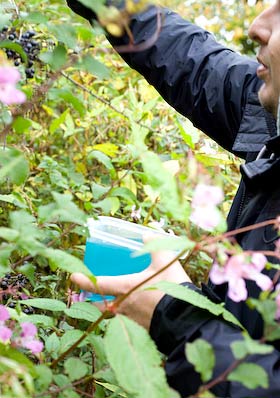
I noticed some sloes on our first walk, so on the second day we remembered to take a container so we could gather some. My brother, Chris, waded through the surrounding himalayan balsam to get up close to the bushes and triggered off a volley of exploding seed heads in the process. You could hear them popping all around us. Growing nearby, there were lots of spindle trees with shocking pink flower clusters showing bright flashes of their orange seeds beneath.
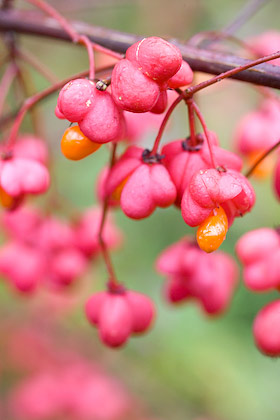
The sloes were almost over but there was still some plump fruits to be had. We ended up with a container full, just enough to start off a couple of bottles of sloe gin. Sloes are meant to be best picked after a first frost but I don’t really understand the timing for this to work right, as the sloes were nearly finished but it is still too early for a frost. You can put the sloes in the freezer to mimic these conditions if you like but I haven’t bothered. This seems like a mere detail.
I always like the opportunity of using my special ‘sloe pricking doofer’. I have already used it this year as a ‘damson pricking doofer’ so it could be classed as a multi-tool. This handy little homemade gadget was copied from one lent to me years ago by a neighbour. It is simply made from an old wine cork, cut into three sections, with clusters of pins pushed through both end bits. It makes pricking the berries a speedier operation and for the rest of the year the spikey ends push into the middle section of cork, to store away safely till next time.
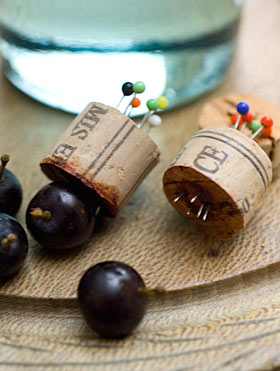
You don’t really need a recipe for sloe gin as such. I have spent endless time past looking up the ratio of sloes to gin to sugar, but all you need to know is to choose a bottle with a top wide enough to take the fruits. Prick them with a toothpick, bodkin or if you are lucky enough to own one, a special ‘doofer’, and half to two third fill the bottle with fruit. Add some sugar, just two or three tablespoons to a 500ml size bottle, you can always add more later if you want a sweeter liqueur. Then fill up the bottle with gin and seal with a cap or cork. Store the gin in a dark place for three months or more, giving the bottle a shake every now and again until the sugar is completely dissolved. It will be ready to drink by Christmas and makes a great present.
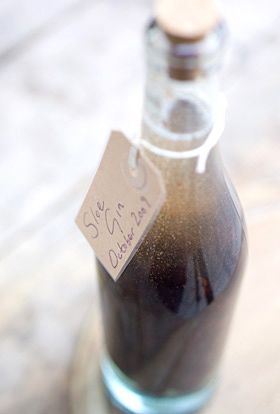
EVERYBODY MUST GET STONED
Friday September 11th 2009, 4:55 pm
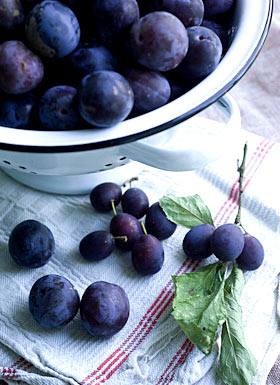
I’m down to my last colander full of damsons. They need using up in the next day or two, otherwise they’ll be over and done with and I hate to waste any of this glorious fruit. I’ve made half a dozen jars of damson chutney, which is already pretty fantastic (if I say so myself) even without its mellowing off period of at least 6 weeks and there’s now several containers full of fruit in the freezer, cooked and stoned to use later.
I always remove the stones from damsons even though it very quickly becomes an arduous job, but it is so worth it after the event. I’ve had several evening sessions of filching these tiny stones out of the cooked fruit by hand, with the pan on my lap whilst watching tv. Here’s a tip; before you plunge your scrupulously clean hands into the pan of squidgy fruity mush, be sure you have chosen your tv channel. The other night I had to decide whether to abandon the stoning in order to get cleaned up to switch channels, or to watch Rambo. I ended up watching an hour of Rambo.
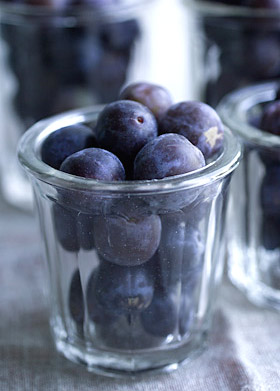
I need to start some damson gin, so some of the remaining damsons are designated for that. The other day I donated some 2 year old damson gin to my neighbour Steve, to include as part of a hamper he was making up for a friend’s wedding gift. I love to make these things, then don’t get round to drinking them. The deal was that he’d replace the gin so I could start off another batch.
I never bother straining the matured gin off the fruit so wasn’t sure whether this would have had a detrimental effect on the taste. We decided we had better sample it first to be on the safe side, so the two of us stood in his kitchen, sipping and savouring, to see if it would pass muster and discussing the finer points of the flavour. It was like a heavenly nectar with just the slightest hint of almond, which was very lovely indeed. As is the way with fruit containing stones, such as apricots, peaches, cherries and plums, the kernels do have this almondy vibe, and damson stones left to steep in gin for any length of time will likewise imbue this flavour.
In Jane Grigson’s Fruit Book she includes a recipe for Plum Stone Noyeau, a flavouring to use for puddings and cakes made before the advent of almond essence. Basically you steep cracked plum kernels in eau de vie or vodka for several months. I intend to give this a go using my discarded damson stones, though bruising and cracking them with a hammer could prove a particularly dangerous occupation.
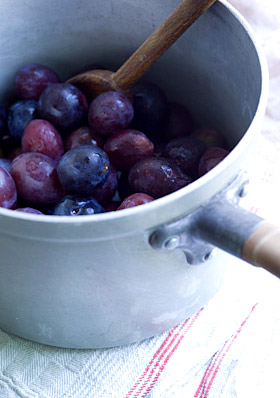
WILD GREENGAGE AND VANILLA JAM
Sunday August 23rd 2009, 9:31 pm
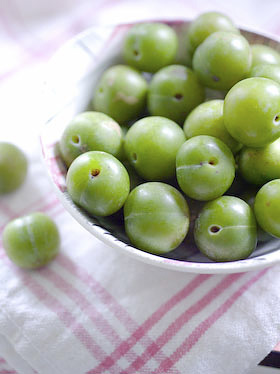
Greengages have always been a mystery to me, my only experience of them being when I was at primary school and for a fleeting moment you could get Penny Arrows in greengage flavour. For anyone unfamiliar with this retro confection, it was a strap of flavoured toffee available from the ‘penny tray’ in the sweet shop on the way home. Plain toffee was the regular flavour but they introduced others from time to time for short runs. I could just about cope with butterscotch, or even banana flavoured Penny Arrows but greengage was a step too far, quite weird and highly scented. That was my first taste of what I thought was the flavour of greengage and it very nearly scarred me for life.
The other day, Irene, my neighbour, asked me if I could take some greengages off her hands, as she wasn’t able to use all the ones she had been given. Of course, I jumped at the opportunity and promptly received a small bag full of washed and sorted fruit. With the Aylburton village horticultural show now only a week away I’ve been busy all week trying to cook up what will hopefully be a prize winner for the show.
These greengages, apparently a wild cultivar, were very small and round, each fruit no bigger than 3cm in diameter and there was 650g of fruit. I decided to add just vanilla and sugar. I sniffed the fruits to see if they bore any resemblance to the Penny Arrows of my youth and thankfully they didn’t. This wasn’t a lot of fruit to play with and I could have done with using a smaller pan than my preserving pan, as the bubbling syrup almost burnt during the rolling boil stage, so the recipe that follows has been doubled up to a more manageable quantity.
Cooked greengages are rather odd, the flesh an unattractive shade of slimy yellowish green and the skins go brown as they cook. Wanting the jam to have a good appearance for the village show, I made the decision to put the cooked fruit through my trusty and much loved food mill to give a better looking result. Jam made this way does still have some texture but the overall appearance is even and foamy. It makes a jam that is very easy to eat but you can leave the stones and skins in if you prefer for a more textured whole fruit in syrup finish.
I have to say, the finished product is absolutely wow, still slightly tart, zingy, sherberty and packed with flavour. I don’t know whether larger cultivated fruits would make a jam quite this fabulous, I’m on the look out for some to compare. If you can find the fruit, do give this recipe a go.
Wild Greengage & Vanilla Jam Makes approx 1.3Kg (3 lbs)
1.3Kg greengages
2 vanilla pods
approximately 800g sugar
Choose ripe to slightly underripe fruit, washed and sorted and place in a pan with the vanilla pods and 3 tablespoons of water. Cook gently to start the juices flowing, adding more water if necessary to stop the fruit catching on the bottom of the pan. Simmer gently until the fruit is cooked through and juicy, approximately 10 – 15 minutes. Remove from the heat, cover the pan and set aside in a cool place for between 12-24 hours.
The fruits will have split during cooking. With clean, washed hands fish around amongst the fruit and remove all the stones and the vanilla pods. Force the fruit through a food mill or a sieve so the skins are left in the food mill and you end up with a bowl of funny looking puree! Weigh it. You should have approximately 870g. You can match this amount with sugar but I prefer to use less, so I used 85-90% sugar to fruit = 780g sugar. Put the sugar in a bowl in the oven to warm along with the clean dry jars.
Split the vanilla pods and scrape out the seeds. Place them and the pods back in the puree and warm through before adding the sugar. Keep stirring until the sugar has completely dissolved, then turn up the heat and boil until the jam reaches setting point, keeping an eye on it to be sure it doesn’t burn. (Test a splodge of jam on a cold plate or use a jam thermometer for this. Refer to my book if you haven’t done this before.) It only took about 5 minutes to boil the syrup to a softish set, so do watch that you don’t cook too fiercely or the jam will burn. If you cook it on further you will be able to achieve a thicker set more like a fruit butter or cheese. Take care removing the pods then pour into jars and seal. Label when cold.
YESTERDAYS HAUL
Wednesday August 19th 2009, 9:36 am
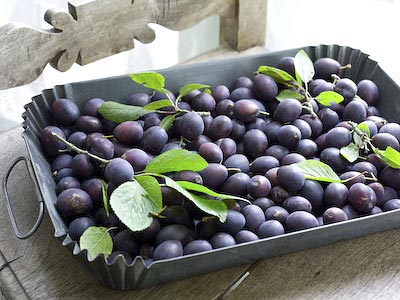
I thought I would post some pictures of the wild damsons I found growing by the roadside in the heart of the forest. I really must remember to keep a set of step ladders in the car for such eventualities, as there is always fruit just out of arms reach that you have to come to terms with giving up on.
When I got home a neighbour had left a bag of plums hanging on the door handle of the front door. I’m not sure who, but I suspect it was Helen and Steve (at the end) who two days ago passed by as I wobbled about on the top of a stone wall, picking more damsons from a tree overhanging the road. Those damsons were growing in someones garden and are larger than the wild ones I found yesterday. I hasten to add I had permission to wobble about on their wall. Helen and Steve asked me if I was scrumping (is it called scrumping for plums, or does that term only apply to apple picking?). I think I may be gaining a reputation.
I am thrilled with my damson crop as they are just about my favourite fruit for preserving and don’t need to be used in any oity-toity combination with anything. They are just perfect on their own.

A PURVEYOR OF OLD TATT
Tuesday August 18th 2009, 5:08 pm

I’ve just been out on a little jaunt. Feeling haunted by thoughts of a kitchen cabinet, spotted on my wanderings yesterday but not purchased at the time I decided that £5 was a snip for this modest item with original 60’s patterned formica top, and so closed the shop for an hour to go and buy it. I would most likely have saved the cost of the cupboard in petrol money if I’d bought it yesterday – such is the folly of cost cutting mind games.

The cupboard was at my favourite second hand place in the forest, called Gorsty Knoll. I am in two minds as to whether I should make the name public, as I don’t really want the world and his wife trying to find it, but in a way, the name is as strange as the place, so I think it merits a mention. Basically, this second hand furniture dealer sells a load of old tatt; house clearance boxes, old cutlery that has seen better days and that was never up to much in the first place, divan beds and comfy but ugly sofas. There is always a big pile of broken furniture by the door, chairs missing a leg and bits of rusty old bedsteads.

I absolutely love the place. You always feel that there is a hidden gem just waiting to be discovered and I have found a few over the years. This guy doesn’t seem to bother with textiles. I’ve asked him before and he says that linens are usually thrown away or taken to the charity shop. As I was leaving with my new purchase in the back of the car I caught a glimpse in the back of his van, the van he uses to do his house clearance jobs and thought how great all the blankets looked hung on the bars lining the inside. He thought I was mad when I asked if I could climb inside and take some pictures, he hadn’t ever looked at them in that way. As I drove away I realised that the road was lined with wild damson trees covered in fruit, screeched to a halt, parked up pronto and filled a bag with them. What a flippin’ fab day out.

IT’S SHOW TIME
Sunday August 16th 2009, 4:00 pm

The village fruit and veg show is only 2 weeks away, so I need to get my skates on. Last year I managed a 3rd prize for my crab apple jelly and a second prize for my damson chutney and I would love to do better this time round. As my book came out earlier this year, I now feel I have my reputation as well as fruit to preserve.
The blackberries round here are particularly plump and abundant this year. Last year I did manage to gather some but each berry was small with not a lot of juice. This year it is a very different matter. Yesterday evening I went out to pick some, along with my cat Beau. He wasn’t any help but did bring a certain cute factor to the proceedings. I managed to harvest a large plastic box full in a very short time and as it is still early in the season, I know there will be lots more fruit to come over the next few weeks.
The plan, to make blackberry and nectarine jam, as I picked up some nectarines in the supermarket this week, reduced with yellow labels! (I have become the yellow label queen). I made this preserve for the book and it was a great success. In the recipe it does have added spices in the form of star anise, cloves and cinnamon, but I’m going to forgo the spiced approach and hope the fruit flavours are tasty enough to stand alone. I do love using nectarines in jams as they have a lovely acidic flavour.
There are elderberries almost ready to pick here, so blackberry and elderberry jam is the next jam I’m planning. I love the idea of using two foraged-for-free fruits together.
Plum and elderberry, again there are lots of plums up for grabs on the trees a mere hop skip and a jump from my front door so it seems a shame not to use them up pronto.
Rhubarb and apricot jam, another real star from the book and fast becoming my signature jam, if you can have such a thing. My neighbours rhubarb keeps on coming and I’ve bought some French apricots, as I don’t grow them myself or know anyone with some to spare. So that’s it for starters. Next week is going to be a busy week.
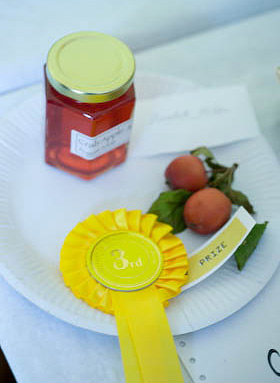
CRAB APPLE JELLY AT LAST YEARS VILLAGE SHOW








